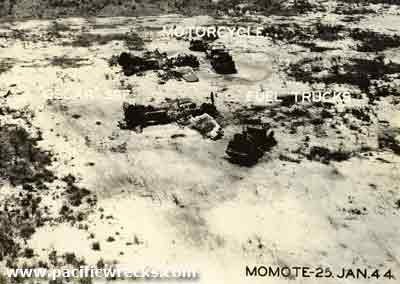Background
The Japanese Army Air Force (JAAF) 63rd Hiko Sentai (63rd Flying Regiment) operated the the Type 97 Fighter / Ki-27 Nate and later the Type 1 Fighter / Ki-43 Oscar.
Markings
The Sentai motif was a stylized triangle on the tail. 1st Chutai white with red edge. 2nd Chutai red, 3rd Chutai yellow.
Wartime History
The 63rd Sentai arrived in the Southeast Area (New Guinea) in at least two phases. In late December 1943 the unit 2nd Chutai and 3rd Chutai arrived in Hollandia. During early January 1944 operated from Wewak.
On January 16, 1944 the 63rd Sentai flew their first combat mission in New Guinea a fighter sweep over Nadzab Airfield. The formation also included Ki-43 Oscars from the 59th Sentai and 248 Sentai plus Ki-61 Tony from the 68th Sentai. Over the Saidor and over the sea to the north their formation was intercepted by P-40 Warhawks that claim 19 confirmed kills and 3 probables. This combat set the wartime record for 5th Fighter Command for victories claimed by a single squadron during a single engagement. The 63rd Sentai lost five Oscars and their pilots including: 1st Lt. Kiyoshi Hasegawa, Sgt Major Tadashi Oishi, Cpl Mitsuhiro Kono, Sgt Major Isao Iwamitsu.
On January 18, 1944 participated in another fighter sweep.
 Detachment of twelve aircraft from the 3rd Chutai was sent to operate from Hyane Airfield (Momote Airfield) on Los Negros Island (Hyane). On January 24, 1944 twelve Ki-43s from the unit were destroyed during a U.S. raid including Ki-43
5807, Ki-43 6132, Ki-43 6139, Ki-43 6145,
Ki-43 6150, Ki-43 6153, Ki-43 6155, Ki-43 6150 (had old style leak proofing). The next day, the burned out wreckage of of the unit's fighters near refueling bowser trucks were photographed at low level by B-25s. Afterwards the survivors withdrew to Hollandia.
Detachment of twelve aircraft from the 3rd Chutai was sent to operate from Hyane Airfield (Momote Airfield) on Los Negros Island (Hyane). On January 24, 1944 twelve Ki-43s from the unit were destroyed during a U.S. raid including Ki-43
5807, Ki-43 6132, Ki-43 6139, Ki-43 6145,
Ki-43 6150, Ki-43 6153, Ki-43 6155, Ki-43 6150 (had old style leak proofing). The next day, the burned out wreckage of of the unit's fighters near refueling bowser trucks were photographed at low level by B-25s. Afterwards the survivors withdrew to Hollandia.
Richard Dunn adds:
"The chutai wiped out on Negros was the 3/63rd. Wrecks found there included
5807, 61- 32, 39, 45, 50, 53, and 55. 5807 and 6150 had old style leak proofing.
The others had more modern self-sealing tanks. Interestinly Japanese documents
contradict this evidence somewhat. They show 6131 left at Hyane but 6132 turned
into the Branch Depot at Hollandia. Looks like either the Americans or
Japanese made a typo. Documents specifically mention Ki 43 No. 6136 being turned into the 209 Branch
Depot salvage dump "completely damaged" in Jan 44. Another interesting
tidbit the 28 (apparently) fighters arrived by Jan 44 were equipped with one "Fixed
machine cannon model 3" and one 'experimental 12.7mm'. They show 6131 left at Hyane but 6132 turned
into the Branch Depot at Hollandia. Looks like either the Americans or
Japanese made a typo."
On February 9, 1944 the 1st Chutai departed with twelve Ki-43s plus four transport aircraft flying from Japan via Akeno-Nittahara-Byoto-Manila-Davao-Babo before reaching Hollandia.
On July 25, 1944 the 63rd Sentai was disbanded.
References
Emblems of the Rising Sun (1999) page 30 (63rd Sentai 1943-1945)
Japanese Army Air Force Fighter Units And Their Aces 1931-1945 (2002) pages 44 (January 16, 1944), 155-156 (63rd Sentai), 300 (pilot losses 1/16/44)
248th Hiko Sentai: A Japanese “Hard luck” Fighter Unit, Part 3 by Richard Dunn
"The following day [January 16, 1944] Major Kiyoshi Kimura of the 68th Sentai led the Japanese fighter force. The 248 th under Capt. Tozuka flew as part of the 59th's formation led by Capt. Shigeo Nango, one of the most successful Japanese fighter pilots in New Guinea. The Japanese flew to the Madang area to challenge American strike aircraft. The mission proved disastrous. No pilots were lost from Nango's formation but the other Japanese units suffered heavily. The 68th and newly arrived 63rd Sentai suffered the loss of seven pilots including Major Kimura and W.O. Noguchi. It seems in total ten Japanese fighters were shot down. Most of these fell victim to fifteen P-40Ns of the 35 th FS, which claimed nineteen victories. Some may have fallen when a few of the Japanese fighters attacked two formations of B-25s that claimed to have destroyed three ZEKES (including fighters reportedly seen to crash into the sea from low level). Finally the Japanese fighters engaged in a 25-minute combat with sixteen P-38s. For the day the Japanese claimed seven bombers, three P-38s and three P-40s. Only one B-25 was lost and a few others damaged. Three P-40s and three P-38s were damaged."
Contribute
Information
Do you have photos or additional information to add?